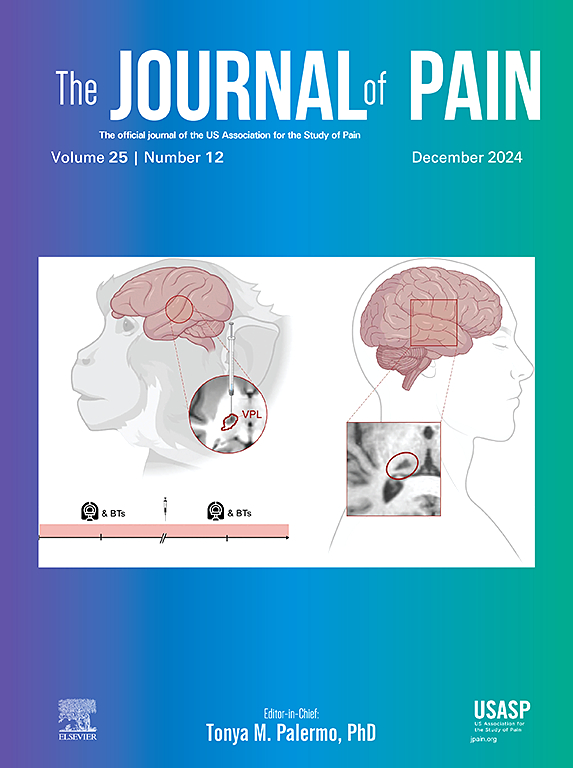使用 Kratom(Mitragyna Speciosa)进行疼痛自我管理:横断面和生态学瞬间评估数据的启示。
IF 4
2区 医学
Q1 CLINICAL NEUROLOGY
引用次数: 0
摘要
尽管对 Kratom(Mitragyna speciosa)的有效性和安全性研究有限,但在美国,越来越多的人将其用于疼痛的自我管理。为了更好地了解人们如何以及为什么使用 kratom 进行疼痛自我管理,我们分析了全美 kratom 消费者的基线调查数据(395 人)和 15 天生态瞬间评估(EMA)数据(357 人)。虽然我们招募参与者的依据是他们使用 kratom 的情况,而不是他们是否使用 kratom 来控制疼痛,但有近一半(49.1%)的参与者符合慢性疼痛的标准,其中许多人报告说他们的疼痛得到了很大缓解,而且 kratom 在控制疼痛方面效果显著。大多数人(69.2%)表示难以获得适当的疼痛治疗,大多数人表示这些困难影响了他们尝试使用 kratom 的决定。大多数参与者并不担心过度使用或严重的副作用。EMA 数据显示,无论慢性疼痛状况如何,缓解疼痛是最常被认可的日常使用 kratom 的主要动机。每天的疼痛程度与使用 kratom 的频率之间没有明显联系,有慢性疼痛与没有慢性疼痛的人每天使用 kratom 的次数也没有差异。近期使用 kratom 与当前疼痛程度较低有关。较强的 Kratom 主观效果与较低的疼痛程度有关。这种效应在很大程度上受慢性疼痛状况的影响:慢性疼痛患者的主观克来托效果与疼痛减轻之间的联系更强。这些发现突出表明,迫切需要对 kratom 在疼痛治疗中的长期影响、疗效和安全性进行系统、严格的研究,以指导知情的临床实践和监管政策。观点:这项研究揭示了慢性疼痛在 kratom 消费者中的普遍性,他们经常使用 kratom 进行疼痛自我管理,并报告说,正如生态学瞬间评估所显示的那样,他们的疼痛得到了明显缓解。目前迫切需要对 kratom 的安全性、功效和机制进行研究,以指导临床实践和制定相关政策。本文章由计算机程序翻译,如有差异,请以英文原文为准。
Kratom (Mitragyna speciosa) use for self-management of pain: Insights from cross-sectional and ecological momentary assessment data
Kratom (Mitragyna speciosa) is increasingly used in the US for self-management of pain, despite limited research on its efficacy and safety. To better understand how and why people use kratom for pain self-management, we analyzed baseline survey data (N = 395) and 15-day ecological momentary assessment (EMA) data (N = 357) from kratom consumers across the US. Although we recruited participants based on their kratom use, not on whether they used it for pain management, nearly half (49.1 %) met criteria for chronic pain, with many reporting substantial pain relief and high effectiveness of kratom in managing pain. A majority (69.2 %) reported difficulties in obtaining adequate pain treatment, and most indicated that these challenges impacted their decision to try kratom. Most participants did not report concerns about overuse or significant side effects. EMA data showed that, regardless of chronic-pain status, pain relief was the most frequently endorsed primary motivation for daily kratom use. There were no significant association between daily pain levels and kratom use frequency, and no difference in the daily kratom use between those with vs. without chronic pain. Recent kratom use was associated with lower current pain levels. Stronger subjective effects of kratom were associated with lower pain levels. This effect was significantly moderated by chronic-pain status: those with chronic pain showed a stronger link between subjective kratom effects and pain reduction. These findings underscore the urgent need for systematic, rigorous research on long-term implications, efficacy, and safety of kratom in pain management to guide informed clinical practices and regulatory policies.
Perspective
This study reveals that chronic pain is common among kratom consumers, who frequently use it for pain self-management and report significant relief, as shown by ecological momentary assessment. There is an urgent need for research into kratom's safety, efficacy, and mechanisms to guide clinical practice and inform policies.
求助全文
通过发布文献求助,成功后即可免费获取论文全文。
去求助
来源期刊

Journal of Pain
医学-临床神经学
CiteScore
6.30
自引率
7.50%
发文量
441
审稿时长
42 days
期刊介绍:
The Journal of Pain publishes original articles related to all aspects of pain, including clinical and basic research, patient care, education, and health policy. Articles selected for publication in the Journal are most commonly reports of original clinical research or reports of original basic research. In addition, invited critical reviews, including meta analyses of drugs for pain management, invited commentaries on reviews, and exceptional case studies are published in the Journal. The mission of the Journal is to improve the care of patients in pain by providing a forum for clinical researchers, basic scientists, clinicians, and other health professionals to publish original research.
 求助内容:
求助内容: 应助结果提醒方式:
应助结果提醒方式:


